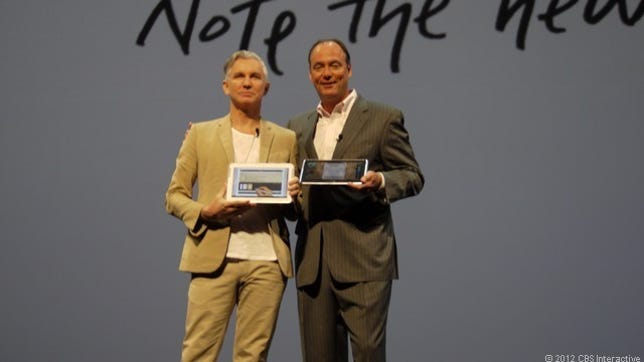The Galaxy Note 10.1 doesn’t just represent a new product, it also represents another shot for Samsung Electronics to do the tablet business right.
It’s no secret that Samsung’s Galaxy Tab line has done poorly, with recent court filings revealing the company sold a total of 1.4 million tablets, including the original Galaxy Tab, the Galaxy Tab 10.1, and Galaxy Tab 10.1 LTE — a mere fraction of the millions of iPads that Apple has been able to sell in the same period.
That’s largely why Samsung is putting its resources behind the Galaxy Note 10.1. The company didn’t announce this product once, or twice, but three times: first in Barcelona at Mobile World Congress; then with a second international announcement two weeks ago; and then a third one in the U.S. at a splashy event in Manhattan today.
Related stories
- Best Samsung Galaxy Z Flip 4 Cases
- TV in the Bathroom: Technically Doable but a Very Bad Idea
- Samsung TV Sale: Save Up to $800 on Select Models at Best Buy
- Best Cordless Vacuum Deals: Save $168 on LG CordZero A9, $100 on Dyson V8 and More
- Please, Clear Your Android Phone’s Cookies and Cache Right Now
Samsung is hoping to parlay some of the goodwill garnered from the surprisingly successful original Galaxy Note and turn it into momentum for the Note 10.1. That, in turn, may spark renewed interest in its tablet business and potentially allow it to break away from a crowded pack of me-too products.
“Launching a tablet with a new name gives Samsung a chance for a fresh start,” said Ross Rubin, an analyst at research firm Reticle.
That Samsung is putting its resources behind a different brand underscores the early difficulties many companies have had in the market for slates.
Even a Samsung executive acknowledged in February that the company wasn’t “doing very well in the tablet market” — as frank an assessment as you’ll ever get from the corporate world.
Despite the success Samsung has had in forging the Galaxy S as its premium line of smartphones and a brand that rivals the iPhone in anticipation and hype, the company hasn’t been able to emulate that progress in tablets. Though the initial Galaxy Tab stood out as a rare early alternative to the iPad, it never sold very well, with its successor products doing even worse.


Brian Bennett/CNET
Samsung, however, has higher hopes for its Galaxy Note 10.1. Despite initial skepticism that the original Galaxy Note’s 5.3-inch display was too big, the device has surpassed expectations, with the company quick to claim a hit product.
The company says it has sold 10 million units of the Galaxy Note in the past nine months.
Samsung itself has never pigeonholed the original Galaxy Note, which is available in the U.S. via AT&T and T-Mobile USA, as a phone or tablet, as its marketing would suggest. Industry observers had taken to calling it a “phablet.”
Either way, it’s hoping that the cachet built up by the Note can carry over to the larger 10.1 tablet version.
But where does that leave the Galaxy Tab? Samsung has already unveiled or launched a dizzying number of different tablet sizes and features, all under the Tab name. It isn’t going away, according to Nick DiCarlo, a product executive with Samsung Telecommunications America.
The market can support both the Note and Tab lines of tablets, DiCarlo said, adding that they would target different demographics. The Tab would go after customers looking for the standard tablet, while the Note would be a higher-end product for people looking to write, draw, or use their tablets for more creative purposes.
Earlier today, Verizon Wireless said it was adding an LTE-enabled Galaxy Tab 2 7.0 to its tablet lineup.
Samsung Galaxy Note 10.1 has stylus to spare (pictures)






+6 more
The Note is positioned as the flagship product, with the Tab as more of the value option, Rubin said. He added that in the short term, he believes both the Tab and Note lines can co-exist.
DiCarlo added he wasn’t afraid of the Note potentially cannibalizing the Tab products but said that it remained really early in the tablet business.
“You can’t call winners and losers yet,” he said.
Samsung, however, still has a long road to travel before its tablet even gets near the iPad’s orbit. The latest global market share data from IHS has Apple commanding a dominating 70 percent of the market in the second quarter, while Samsung could muster up only a 9-percent share.
The tablet market’s potential has drawn in a number of different companies, from Amazon and its Kindle Fire to Google and its Nexus 7. While there’s a lot of buzz for the Nexus 7, which wasn’t included in the IHS study, few other tablets beyond the iPad have gained much attention.
Still, the Note 10.1 could stand apart from the crowd with its S-Pen. The stylus is one feature that Samsung can confidently claim has nothing to do with copying Apple. (Full coverage of the Apple v. Samsung trial).
Even if Steve Jobs famously criticized the concept of a stylus, perhaps enough consumers will take an interest in it to give Samsung the shot in the arm that it needs.


Now playing:
Watch this:
Samsung Galaxy Note 10.1
1:28



